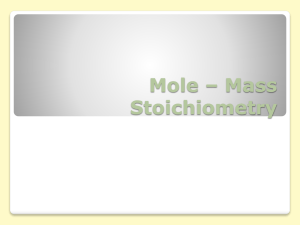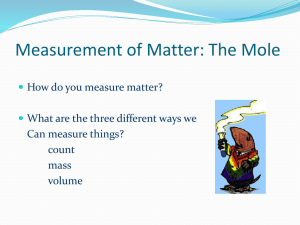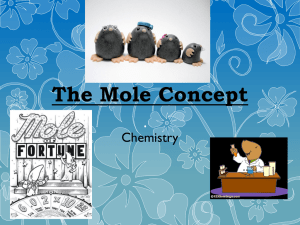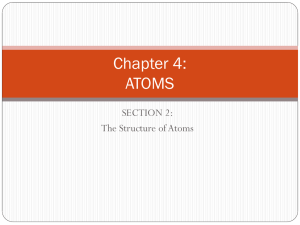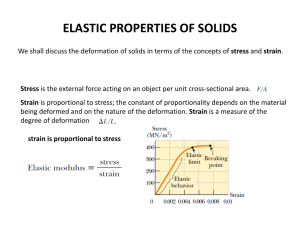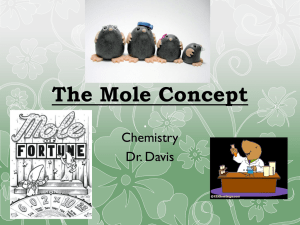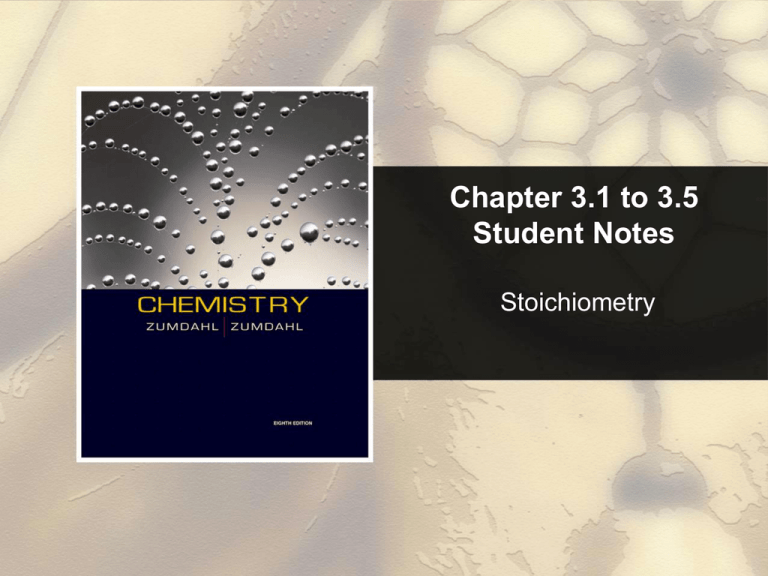
Chapter 3.1 to 3.5
Student Notes
Stoichiometry
Chapter 3
Table of Contents
3.1
3.2
3.3
3.4
3.5
3.6
3.7
3.8
3.9
3.10
Counting by Weighing
Atomic Masses
The Mole
Molar Mass
Percent Composition of Compounds
Determining the Formula of a Compound
Chemical Equations
Balancing Chemical Equations
Stoichiometric Calculations: Amounts of Reactants
and Products
The Concept of Limiting Reagent
Copyright © Cengage Learning. All rights reserved
2
Chapter 3
TUESDAY - B DAY - SEPT. 17, 2013
Table of Contents
•
•
•
•
Pick up calculator, notes packet, and pre-lab packet.
CW: Notes 3.1 to 3.5
CW: Finish Test part 2 ch.1-2 if not done yet
CW/HW: Read lab and complete Pre-lab questions.
Note that the reading helps with the pre-lab questions
due Thursday for lab. Try to be here by 7:45 for setup to
give us time to discuss pre-lab and complete lab.
• HW: Section 3.1-3.5 pg. 117 #21, 26, 27, 29, 30, 31, 33,
35, 37, 39b,45b, 47b, 49b, 52, 57a-g, 61, 63 due
Monday 9/23/13 to go over.
3
Chapter 3
Chemical Stoichiometry
• Stoichiometry – The study of quantities of materials
consumed and produced in chemical reactions.
• Some types of stoichiometry types:
– moles to moles, moles to mass, moles to #particles
– mass to mass, mass to particles, or mass to moles
– particles (Avogadro’s #)
– also for gases at STP, volume conversions can be
added as 22.4 L = 1 mole of any gas at STP
– Video link only if need some review
– http://www.youtube.com/watch?v=poRTFPE1jUk
Copyright © Cengage Learning. All rights reserved
3
Section 3.1
Counting by Weighing
Exercise
A pile of marbles weigh 394.80 g. 10 marbles
weigh 37.60 g. How many marbles are in the
pile?
Return to TOC
Copyright © Cengage Learning. All rights reserved
5
Section 3.1
Counting by Weighing
•
•
Need average mass of the object.
Objects behave as though they were all
identical.
•
Carbon-12 standard
•
“An atomic weight (relative atomic mass) of an element
from a specified source is the ratio of the average mass per
atom of the element to 1/12 of the mass of 12C" in its nuclear
and electronic ground state.
Return to TOC
Copyright © Cengage Learning. All rights reserved
4
Section 3.2
Atomic Masses
Counting
by Weighing
•
•
Elements occur in nature as mixtures of
isotopes.
Carbon = 98.89% 12C
1.11% 13C
< 0.01% 14C (which is too
– small to affect the overall average)
Return to TOC
Copyright © Cengage Learning. All rights reserved
6
Section 3.2
Atomic Masses
Counting
by Weighing
Average Atomic Mass for Carbon
CALCULATING THE AVERAGE ATOMIC MASS
98.89% of 12 amu + 1.11% of 13.0034 amu =
exact number
(0.9889)(12 amu) + (0.0111)(13.0034 amu) =
12.01 amu
Return to TOC
Copyright © Cengage Learning. All rights reserved
7
Section 3.2
Atomic Masses
Counting
by Weighing
Average Atomic Mass for Carbon
•
•
Even though natural carbon does not
contain a single atom with mass 12.01, for
stoichiometric purposes, we can consider
carbon to be composed of only one type of
atom with a mass of 12.01.
This enables us to count atoms of natural
carbon by weighing a sample of carbon.
Return to TOC
Copyright © Cengage Learning. All rights reserved
8
Section 3.2
Schematic Diagram of a Mass Spectrometer
Atomic Masses
Counting
by Weighing
Figure 3.1 (left) A Scientist Injecting a Sample into a Mass
Spectrometer. (right) Schematic Diagram of a Mass
Spectrometer
*Mass spectrometer - Most accurate method for comparing the masses
of atoms and determining the isotopic composition of a natural element.
Return to TOC
Copyright © Cengage Learning. All rights reserved
9
Section 3.2
Mass Spectrometer - Evaluating the data
Atomic Masses
Counting
by Weighing
• For this element, there are 3 isotopes with a mass of 20,
21, and 22. From the 2nd graph, we determine that 91%
is 20 amu, 0.3% 21 amu, and 9% 22 amu. What
element do you think we have?
Did you say Neon? You would be correct!
Return to TOC
11
Section 3.2
Atomic Masses
Counting
by Weighing
CALCULATING AVERAGE ATOMIC MASS
• EXAMPLE 1
• The natural abundance for boron isotopes is:
• 19.9% 10B (10.013 amu) and 80.1% 11B (11.009amu).
Calculate the atomic weight of boron.
•
Atomic Mass =
[(mass of isotope) (%abundance) ] + [(mass of isotope) (%abundance)] + [….]
• % abundance is expressed as a decimal and the sum is
continued for any other existing isotopes.
• (0.199) (10.013) + (0.801) (11.009) = 10.810796 = 10.8 g/mol
• See periodic table to see if this matches up. It should!
Return to TOC
12
Section 3.2
Atomic Masses
Counting
by Weighing
Exercise - Complete and show work in notes.
An element consists of 62.60% of an isotope
with mass 186.956 amu and 37.40% of an
isotope with mass 184.953 amu.
• Calculate the average atomic mass and
identify the element. Show work in notes
before checking answer.
Return to TOC
Copyright © Cengage Learning. All rights reserved
10
Section 3.2
Atomic Masses
Counting
by Weighing
Exercise - Complete and show work in notes.
ANSWER BELOW IN GREEN. You must show
your work.
An element consists of 62.60% of an isotope
with mass 186.956 amu and 37.40% of an
isotope with mass 184.953 amu.
• Calculate the average atomic mass and
identify the element. Show work in notes.
186.2 amu
Rhenium (Re)
Copyright © Cengage Learning. All rights reserved
Return to TOC
10
Section 3.2
AP CHEM STYLE QUESTION
Atomic Masses
Counting
by Weighing
• AP EXAMPLE 1
• Copper exists as two isotopes: 63Cu (62.9298 amu) and
• 65Cu (64.9278 amu).
What are the percent abundances of the isotopes?
• Try to do in your notes with pencil before checking answers.
Return to TOC
15
Section 3.2
AP Example 1 continued with answer
Atomic Masses
Counting
by Weighing
•
Since the overall atomic weight for copper is not given in the problem, you must
look it up in the periodic table to work this solution. Atomic mass for Cu = 63.546
•
Assign x to one of the isotopes:
•
The other isotope is 1-x (1 whole representing 100% but using 1 is easier.)
65Cu
% = x then
63Cu
% = 1-x
•
•
•
•
63.546 = [(1-x)(62.9298)] + [(x)(64.9278)]
63.546 = 62.9298 - 62.9298x + 64.9278x
.6162 = 1.998x
x = .3084 convert to % by x 100 = 30.84% which was
assigned to Cu-65
• Cu-63 then is 1-.3084 (or 100-30.84%) = 69.16%%
Return to TOC
16
Section 3.2
AP CHEM Example type 2
Atomic Masses
Counting
by Weighing
• The atomic mass of lithium is 6.94, the naturally occurring isotopes
are 6Li = 6.015121 amu, and 7Li = 7.016003 amu.
• Determine the percent abundance of each isotope.
• 6.94 =[(% 6Li)(6.015121)] + [(%7Li)(7.016003)]
• Assigning variables for unknown %:
• Let % 6Li = x then %7Li = 1-x (where 1 is 1 whole or 100% you
could do as 100-x also if you like)
• 6.94 = [(x)(6.015121)] +[(1-x)(7.016003)]
• 6.94 = 6.015121x + 7.016003 - 7.016003x (combine like terms)
• -0.076003 = -1.000882 x
• x = 0.075936 = 7.59% Li-6
• and 1-x or 0.924064 = 92.4% Li-7
Return to TOC
17
Moles and Formula Mass
19
The Mole & Avogadro’s Number
• Mole (mol): amount of substance that contains as
many elementary entities as there are atoms in
exactly 12 g of the carbon-12 isotope.
• Atoms are small, so this is a BIG number …
• Avogadro’s number (NA) = 6.022 × 1023 units/mol
• 1 mol = 6.022 × 1023 “units” (atoms, molecules,
ions, formula units, oranges, etc.)
– A mole of oranges would weigh about as much
as the earth!
• Mole is NOT abbreviated as either M or m
The Mole
1 dozen = 12
1 gross = 144
1 ream = 500
1 mole = 6.022 x 1023
There are exactly 12 grams of
carbon-12 in one mole of carbon-12.
Section 3.3
The Mole by Weighing
Counting
•
•
•
The number equal to the number of carbon
atoms in exactly 12 grams of pure 12C.
1 mole of anything = 6.022 x 1023 units of that
thing (Avogadro’s number).
1 mole C = 6.022 x 1023 C atoms = 12.01 g C
Return to TOC
Copyright © Cengage Learning. All rights reserved
11
Avogadro’s Number
6.022 x 1023 is called “Avogadro’s Number” in
honor of the Italian chemist Amadeo Avogadro
(1776-1855).
I didn’t discover it. Its
just named after me!
Amadeo Avogadro
Table 3.1 Comparison of 1 Mole
Samples of Various Elements
Copyright © Houghton Mifflin Company. All rights reserved.
3–
24
Conversions with moles, atoms, 25
molar mass, and volume of a gas at
STP Strategies
The Mole Bridge
26
• Rules for Mole Conversions using the Mole
Bridge
• 1. You can only go from left to right.
(rabbits multiply)
• 2. The great divide side, you will divide.
• 3. On Rabbitville side, you will multiply.
Calculations with Moles:
Converting moles to grams with Dim. Analysis
1.How many grams of lithium are in 3.50
moles of lithium?
3.50 mol Li
6.94 g Li
1 mol Li
=
24.3 g Li
Calculations with Moles:
Converting grams to moles
2. How many moles of lithium are in 18.2
grams of lithium?
18.2 g Li
1 mol Li
6.94 g Li
= 2.62 mol Li
Calculations with Moles:
Using Avogadro’s Number
3. How many atoms of lithium are in 3.50
moles of lithium?
3.50 mol
6.02 x 1023 atoms
1 mol
= 2.11 x 1024 atoms
Section 3.3
The Mole by Weighing
Counting
Concept Check
4. Calculate the number of iron atoms in a 4.48
mole sample of iron. Show your work in your
notes before checking answer.
Return to TOC
Copyright © Cengage Learning. All rights reserved
12
Section 3.3
The Mole by Weighing
Counting
Concept Check
ANSWER IN GREEN
4. Calculate the number of iron atoms in a 4.48
mole sample of iron. Show your work in your
notes before checking answer.
2.70×1024 Fe atoms
Return to TOC
Copyright © Cengage Learning. All rights reserved
12
Section 3.3
The Mole by Weighing
Counting
Definitions of Similar Terms
• Molar Mass is the mass of one mole of a substance (6.02 x 1023 formula
units). The unit for molar mass (note it is the mass of a mole) is
grams/mole.
• Atomic Weight is the molar mass of an element.
• Formula Weight is the molar mass of an IONIC compound.
• Molecular Weight is the molar mass of a COVALENT compound.
• Molecular Mass is the mass of a given molecule (NOT MOLES of
molecules). The units are atomic mass units (amu).
• 1amu =1.660 538 782×10–27 kg
• 1 amu is 1/12 the mass of a carbon-12 atom which has a mass of 12.0000.
Return to TOC
32
Section 3.4
Molar Mass
•
•
Molar Mass
Mass in grams of one mole of the substance:
Atomic Weight of Si = 28.09 g/mol
Molecular mass of N2 = 28.0 g/mol
Molar Mass of H2O = 18.02 g/mol
(2 × 1.008 g) + 16.00 g
Molar Mass of Ba(NO3)2 = 261.35 g/mol
137.33 g + (2 × 14.01 g) + (6 × 16.00 g)
Return to TOC
Copyright © Cengage Learning. All rights reserved
13
34
Molecular Masses and
Formula Masses
• Molecular mass: sum of the masses of the atoms
represented in a molecular formula.
• Simply put: the mass of a molecule.
• Molecular mass is specifically for molecules.
• Ionic compounds don’t exist as molecules; for
them we use …
• Formula mass: sum of the masses of the atoms or
ions present in a formula unit.
35
Determining the Formula Mass
of Ammonium Sulfate
One Mole of
Four
Elements
One mole each of helium, sulfur,
copper, and mercury.
How many atoms of helium
are present? Of sulfur? Of
copper? Of mercury?
36
37
The Mole and Molar Mass
• Molar mass is the mass of one mole of a
substance.
• Molar mass is numerically equal to atomic mass,
molecular mass, or formula mass. However …
• … the units of molar mass are grams (g/mol).
• Examples:
1 atom Na = 22.99 u
1 mol Na = 22.99 g
1 molecule CO2 = 44.01 u
1 mol CO2 = 44.01 g
1 formula unit KCl = 74.56 u
1 mol KCl = 74.56 g
38
CALCULATE MOLAR MASS
Practice calculating the
molar mass of the following
compounds. You may
round to nearest hundredths
when using the mass numbers
from the periodic table.
You can stop at Cu(NO3)2.
39
Conversions involving Mass, Moles,
and Number of Atoms/Molecules
1 mol Na = 6.022 × 1023 Na atoms = 22.99 g Na
We can use these equalities to construct conversion factors,
such as:
1 mol Na
–––––––––
22.99 g Na
22.99 g Na
–––––––––
1 mol Na
1 mol Na
––––––––––––––––––
6.022 × 1023 Na atoms
Note: preliminary and follow-up calculations may be needed.
40
We can read formulas in terms of
moles of atoms or ions.
Section 3.4
Molar Mass
Concept Check
Calculate the number of copper atoms in a 63.55 g
sample of copper.
6.022×1023 Cu atoms
Return to TOC
Copyright © Cengage Learning. All rights reserved
15
Section 3.4
Molar Mass
Concept Check
Which of the following is closest to the average
mass of one atom of copper?
a)
b)
c)
d)
e)
63.55 g
52.00 g
58.93 g
65.38 g
1.055 x 10-22 g
63.546 g/mol so 1 mol/6.022 x 1023 atoms which is g/atom
Return to TOC
Copyright © Cengage Learning. All rights reserved
14
Section 3.4
Molar Mass
Concept Check
Which of the following 100.0 g samples
contains the greatest number of atoms?
a) Magnesium
b) Zinc
c) Silver
Return to TOC
Copyright © Cengage Learning. All rights reserved
16
Section 3.6
Assignments Monday 9/23/13
Determining the Formula of a Compound
• Pick up handouts for use later & have out ch. 3 notes
and HW ch. 3
• CW: Notes 3.5-3.6 finished together
• CW: Empirical and Molecular Formula Race Game
• CW/HW: Notes 3.7-3.8 with computers.
• HW: Formal Lab report due on Wednesday.
• Be sure you completed homework 3.1-3.5 previously
assigned and turn in by Wednesday.
• HW: Empirical Formula and Balancing Equations
w/sheets due on Friday.
• HW: Be reading chapter 3. The next test is over ch.3-4
and is tentatively scheduled for October 16th. Ch. 4 is
mostly new material not covered in Gen. Chemistry.
44
Return to TOC
Section 3.4
Molar Mass
Concept Check
Which of the following 100.0 g samples
contains the greatest number of atoms?
a) Magnesium greatest atoms would be greatest
moles, so convert to moles first 100 g/24.3 g/mol
(about 4 mol)
b) Zinc 100g/65 g/mol = between 1 and 2 mol
c) Silver 100 g/107 g/mol = less than 1 mol
Return to TOC
Copyright © Cengage Learning. All rights reserved
16
Section 3.4
Molar Mass
Exercise
Rank the following according to number of
atoms (greatest to least):
a) 107.9 g of silver
b) 70.0 g of zinc
c) 21.0 g of magnesium
b)
a)
c)
Return to TOC
Copyright © Cengage Learning. All rights reserved
17
Section 3.4
Molar Mass
Exercise
Rank the following according to number of
atoms (greatest to least):
a) 107.9 g of silver change to moles
107.9/107.9=1mol
b) 70.0 g of zinc 70/65.4 = > 1 mol; 1.07 mol
c) 21.0 g of magnesium 21/24.3 = less than 1 mol
b)
a)
c)
Return to TOC
Copyright © Cengage Learning. All rights reserved
17
Section 3.4
Molar Mass
Stopped here with presentation on Tuesday
• stopped to let others finish test and then work on
homework problems or pre-lab... (could have probably
gone longer because most didn’t need much time to
finish.
Return to TOC
48
Section 3.4
Molar Mass
Exercise
Consider separate 100.0 gram samples of
each of the following:
H2O, N2O, C3H6O2, CO2
Rank them from greatest to least number
of oxygen atoms.
H2O, CO2, C3H6O2, N2O
Return to TOC
Copyright © Cengage Learning. All rights reserved
18
Section 3.4
Molar Mass
Exercise
Consider separate 100.0 gram samples of
each of the following:
H2O, N2O, C3H6O2, CO2
18g/mol 44 g/mol
5.5+
2.3
5.5+
2.3
74 g/mol
44 g/mol
1.35
2.3
x2 so 2.7
x2 so 4.6
Rank them from greatest to least number
of oxygen atoms.
Return to TOC
H O, CO , C H O , N O
Copyright © Cengage Learning. All rights reserved
18
Notes 3.5
Mass Percent Composition
from Chemical Formulas
The mass percent composition of a compound refers
to the proportion of the constituent elements,
expressed as the number of grams of each element
per 100 grams of the compound. In other words …
X g element
X % element = –––––––––––––– OR …
100 g compound
g element
% element = ––––––––––– × 100
g compound
51
Section 3.5
Percent Composition of Compounds
•
Mass percent of an element:
•
For iron in iron(III) oxide, (Fe2O3):
Return to TOC
Copyright © Cengage Learning. All rights reserved
20
Calculating Molar Mass
Calculate the molar mass of magnesium carbonate,
MgCO3.
24.31 g + 12.01 g + 3(16.00 g) =
84.32
g/mol
Calculating Percentage Composition
Calculate the percentage composition of magnesium
carbonate, MgCO3.
From previous slide:
24.31 g + 12.01 g + 3(16.00 g) = 84.32 g
24.31
x 100
84.32
12.01
x 100
84.32
48.00 x 100
84.32
28.83% Mg
14.24% C
56.93% O
Total % should be close to
100.00
Section 3.5
Percent Composition of Compounds
Exercise
Consider separate 100.0 gram samples of
each of the following:
H2O, N2O, C3H6O2, CO2
Rank them from highest to lowest percent
oxygen by mass.
H2O, CO2, C3H6O2, N2O
Return to TOC
Copyright © Cengage Learning. All rights reserved
21
Section 3.5
Percent Composition of Compounds
Exercise
Consider separate 100.0 gram samples of
each of the following:
H2O, N2O, C3H6O2, CO2
• 16/18 16/44 32/74
• 89%
36%
43%
32/44
73%
Rank them from highest to lowest percent
oxygen by mass.
H2O, CO2, C3H6O2, N2O
Return to TOC
Copyright © Cengage Learning. All rights reserved
21
Section 3.5
Percent Composition of Compounds
ASSIGNMENTS Ch. 3 Homework - Tuesday - 9/17/13
• HW: Section 3.1-3.5 pg. 117 #21, 26, 27, 29, 30, 31, 33,
35, 37, 39b,45b, 47b, 49b, 52, 57a-g, 61, 63 due
Monday 9/23/13 to go over.
• You must show your work for most of these with
calculations and units. No work for math problems will
receive no points.
• CW: Finish test part 2 if you haven’t.
• HW: Read and complete Pre-lab Determination of the
Molecular Weight of an Acid for lab on Thursday.
Return to TOC
57

